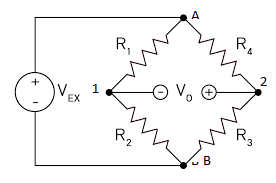
Write Kirchhoff’s first rule (law of junction). Drawing a circuit diagram of Wheatstone bridge, derive condition for zero deflection in the bridge.
Answer
506.1k+ views
Hint: Kirchhoff’s first rule (law of junction) is completely based on the law of conservation of charge. Deflection in bridge is calculated by a Galvanometer, it shows zero reading when there is no voltage between the ends. Hence the voltage

Useful formula:
Ohm’s law is given by,
Where,
Complete step by step solution:
Kirchhoff’s first rule:
Kirchhoff’s first rule (law of junction) states that in an electrical circuit, the algebraic total of current which enters the junction is equal to the algebraic total of current which exits the junction. It is based on the law of conservation of charge.
Assume that,
Voltage at point A is
Voltage at point B is
Voltage at point 1 is
Voltage at point 2 is
Voltage through resistor
Voltage through resistor
Voltage through resistor
Voltage through resistor
Current through resistor
Current through resistor
Current through resistor
Current through resistor
For zero deflection in the galvanometer, the voltage
Hence,
Voltage at point 1 = Voltage at point 2
So, the current passing through the galvanometer is zero.
Hence,
Current through
By using Ohm’s law,
Current through resistor
Since,
Thus,
Current through resistor
Since,
Thus,
Substitute the values of
Similarly,
Current through resistor
Since,
Thus,
Current through resistor
Since,
Thus,
Substitute the values of
Dividing the equation (5) from (3),
By equation (1),
Thus,
Hence, the above condition is the necessary and required condition for the voltage across the bridge
Note: The voltage between the bridge is equal to zero, when the potential between the points 1 and 2 must be zero. Hence the combination of the resistor is very much important. The ratio between the opposite resistance is equal to another side ratio between the opposite resistance. Hence, the combination must be accurate.

Useful formula:
Ohm’s law is given by,
Where,
Complete step by step solution:
Kirchhoff’s first rule:
Kirchhoff’s first rule (law of junction) states that in an electrical circuit, the algebraic total of current which enters the junction is equal to the algebraic total of current which exits the junction. It is based on the law of conservation of charge.
Assume that,
Voltage at point A is
Voltage at point B is
Voltage at point 1 is
Voltage at point 2 is
Voltage through resistor
Voltage through resistor
Voltage through resistor
Voltage through resistor
Current through resistor
Current through resistor
Current through resistor
Current through resistor
For zero deflection in the galvanometer, the voltage
Hence,
Voltage at point 1 = Voltage at point 2
So, the current passing through the galvanometer is zero.
Hence,
Current through
By using Ohm’s law,
Current through resistor
Since,
Thus,
Current through resistor
Since,
Thus,
Substitute the values of
Similarly,
Current through resistor
Since,
Thus,
Current through resistor
Since,
Thus,
Substitute the values of
Dividing the equation (5) from (3),
By equation (1),
Thus,
Hence, the above condition is the necessary and required condition for the voltage across the bridge
Note: The voltage between the bridge is equal to zero, when the potential between the points 1 and 2 must be zero. Hence the combination of the resistor is very much important. The ratio between the opposite resistance is equal to another side ratio between the opposite resistance. Hence, the combination must be accurate.
Recently Updated Pages
Master Class 9 General Knowledge: Engaging Questions & Answers for Success

Master Class 9 English: Engaging Questions & Answers for Success

Master Class 9 Science: Engaging Questions & Answers for Success

Master Class 9 Social Science: Engaging Questions & Answers for Success

Master Class 9 Maths: Engaging Questions & Answers for Success

Class 9 Question and Answer - Your Ultimate Solutions Guide

Trending doubts
Give 10 examples of unisexual and bisexual flowers

Draw a labelled sketch of the human eye class 12 physics CBSE

Differentiate between homogeneous and heterogeneous class 12 chemistry CBSE

Differentiate between insitu conservation and exsitu class 12 biology CBSE

What are the major means of transport Explain each class 12 social science CBSE

Draw a diagram of a flower and name the parts class 12 biology ICSE




